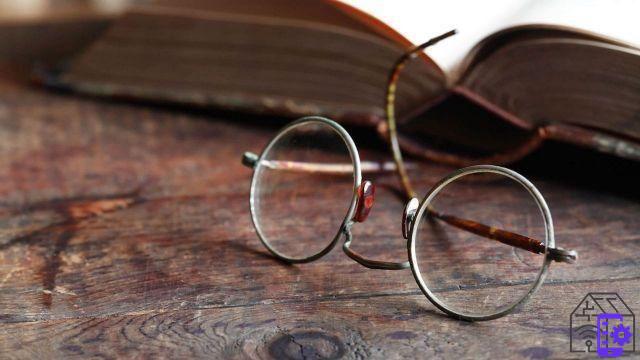
Dear short-sighted, astigmatized, presbyopic and readers with visual disturbances, the column "How has it changed" today is entirely dedicated to you. After having covered the history of some of the most well-known everyday objects of all time, we decided to focus oninvention of glasses. And with good reason. Apparently, in fact, scholars believe that eyeglasses are among the top five most important inventions in human history. Like the fire and the wheel, so to speak. So let's find out who really was the inventor of this wonderful object that over the centuries has allowed billions of people to solve visual disturbances.
The invention of glasses: when it all began
The invention of glasses has its roots in the XNUMXst century AD. In fact, Seneca and Pliny already wrote about some innovative methods for correcting vision disorders. But it was Ibn al-Heitam, Arab scholar and astronomer, to hypothesize that a pair of polished lenses could be a good solution for the purpose of optical improvement - and magnification -. And although the authorship of eyeglasses is not attributed to him, his "Optics Book" was of fundamental importance in the history of this invention. Translated into Latin in 1240, the text began to be appreciated especially within the monastic communities, where the principles of al-Heitam materialized in an amazing object, the "reading stone".
In reality, this object looked more like a magnifying glass than a proper pair of glasses, but the principle of operation was the same. It was one semi-spherical lens, made of rock crystal and quartz, which allowed the letters to be enlarged by placing it on any written page. Now, we can't define these reading stones as spectacles, but as their closest ancestors, yes. Indeed, apparently this invention is actually attributed to a friar of the monastery of Santa Caterina in Pisa, Alessandro Della Spina. It has been written of him: “modest and good, who knew how to do what he saw. The glasses (ocularia) that others had made first and did not want to communicate the secret, he made and to everyone he communicated happy (ylari) and willing “. A prodigious invention, which, however, will only be improved in the centuries to come.
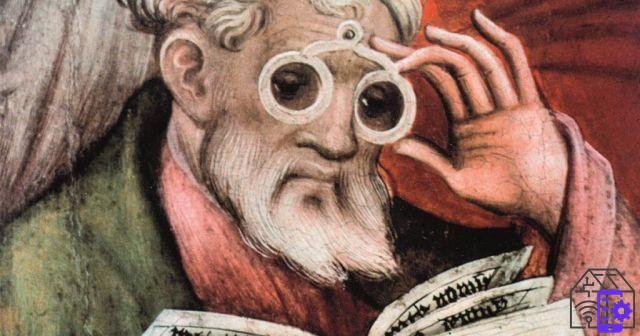
From reading stones to glasses: the evolution of Murano
Where else could the evolution of eyeglasses take place if not a Murano, one of the best known centers for glass processing in XNUMXth century Italy? And it was right here, on this small island north of Venice, that they were able to for the first time fit two convex lenses in wooden circles, held together by a segment and a rivet. Thus were born the "rivet glasses". These, however, had no element that could keep them fixed on the nose, and had to be held with the hand in front of the eyes by the same wearer. Although not yet practical, the use of these glasses was widespread. So that Tomaso of Modena he depicted them in the frescoes in the Chapter Hall of the Dominican convent of San Nicolò in Treviso. And this is just one of the many historical testimonies of the diffusion of this object.
Over the decades, the demand for glasses became more and more massive, so much so that Venice was forced to impose strict rules on glass processing to avoid losing its leadership in production. And so, after 1300 only those who followed the rules of the Murano producers could manufacture what was called the "glass for the eyes". Clearly, over time the glass masters made some interesting changes to the glasses. Among these was the decision of replace wood with lead (heavier and more resistant). Or that of opting for an arch to replace the rivet segment. Or even add a support that allowed people to wear lenses instead of holding them with their hands. And so, around the sixteenth century, glasses began to have the look we know today. Almost.
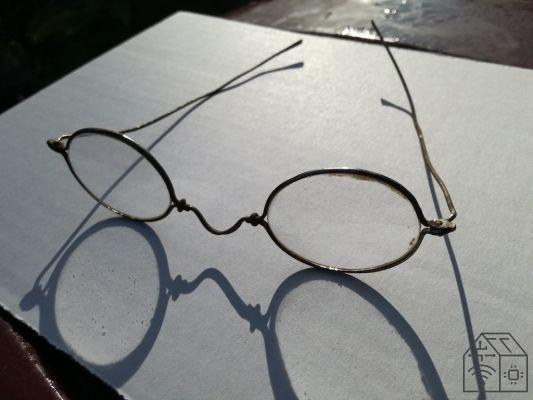
The eyeglass industry
Although the invention of glasses is very old, it was only in the 1728th century that they began to have the appearance we know today. The real big dilemma of glass masters, in fact, was how to keep the lenses adherent to the face, so as to allow people to read and see without any discomfort. It was then that a little everywhere in the world began to look for a solution so that glasses could be worn in a practical way. A brochure of the English optician Scarlett, dated to XNUMX, shows the existence of glasses equipped with a bridge on the nose and a couple of rods that held the lenses in place by resting behind the ears. The so-called "glasses with temples“, Which appeared in 1800 and have reached the present day. Clearly with many design features that have made them more comfortable and practical to wear.
But if on the one hand we concentrated on the design of the glasses, on the other we also worked a lot on the lenses. Apparently, in fact, initially the glasses were designed only for the presbyopic. And only later did they work on a pair of lenses that could also correct the visual disturbance of myopia. Only in the twentieth century, however, did work really begin on the technology of eyeglasses. In 1908, to be precise, it was ZEISS to start working on lenses that would allow you to enjoy the vision ofentire field of view. The research was followed by the scientists Moritz von Rohr and Allvar Gullstrand - Nobel laureate -, who focused mainly on the vision problems of patients with cataracts.
Thus the Punktal, the first focal point lenses which finally allowed us to see through the peripheral areas of the lens itself. An important milestone, considering that before you were forced to turn your head everything you wanted to see something out of your field of vision. But this wasn't ZEISS's only invention. In fact, in 1935 the group launched the first frame on the market that remained attached to the wearer's face. And this marked the actual creation of the first pair of modern glasses.
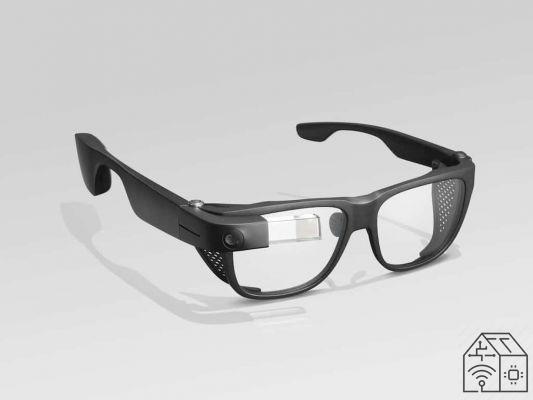
From eyeglasses to smart glasses
Before being able to understand what was the gigantic evolutionary leap that brought us from ZEISS glasses to Google Glass, it should be noted that evolution is linked to the birth of Augmented Reality. This, apparently, dates back to 1966, when Ivan Sutherland developed the first AR device in history, “The Ultimate Display”. In the decades to come, many researchers worked on a device that would allow users to perceive an augmented world. And the glasses immediately proved to be a perfect solution. Vuforlafor example, he was one of the first groups of developers to develop eyewear technology that would allow them to recognize and map 3D images and objects in real time. Then, around 2012, it was Valve to unveil a prototype of glasses for augmented reality.
Then in 2013 it was the turn of the Google Glass, the most anticipated smart glasses ever. A project that however "died" in 2016, given the numerous problems encountered due to the violation of privacy by the device. But Zuckerberg immediately understood the potential of glasses that allow access to Augmented Reality, and set to work on a similar project. On the other hand, being able to access the Instagram and Facebook apps, or Google functions, from the glasses, is a huge step forward for the giants of the sector. But no matter how supportive the technology may be, smart glasses also represent a considerable “danger” for users. This is why it will take a long time before we can get our hands on such an advanced device.
On the other hand, the invention of glasses has taught us that there is a long way to go. And it must be traveled slowly if you want to achieve an excellent result.
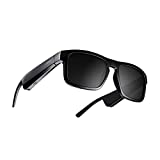 Bose Frames Tenor - Sunglasses with Bluetooth Audio, ...
Bose Frames Tenor - Sunglasses with Bluetooth Audio, ...
- New luxurious design: refined and elegant, the new Bose sunglasses combine advanced functionality and design to ...
- Rectangular Bluetooth Sunglasses: With a lacquered black finish, the Bose Frames Tenor feature a refined ...
- Bose Open Ear Audio Sunglasses: Enjoy realistic audio without disturbing those around you. An experience...
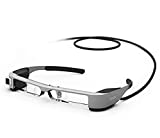 Epson Moverio BT-300 Smartglass Binoculars with Lenti...
Epson Moverio BT-300 Smartglass Binoculars with Lenti...
- A new vision of reality: The Moverio BT-300 smartglasses use the innovative display technology ...
- High contrast for truly realistic Augmented Reality content: With Moverio BT-300, the display space ...
- Superior performance: The powerful 5GHz Intel Atom x1,44 Quad Core CPU and 2GB of RAM ensure performance ...




















![[Review] Samsung Powerbot VR7000: the robot vacuum cleaner from Star Wars](/images/posts/6bc44de38605b5c0fa12661febb1f8af-0.jpg)





